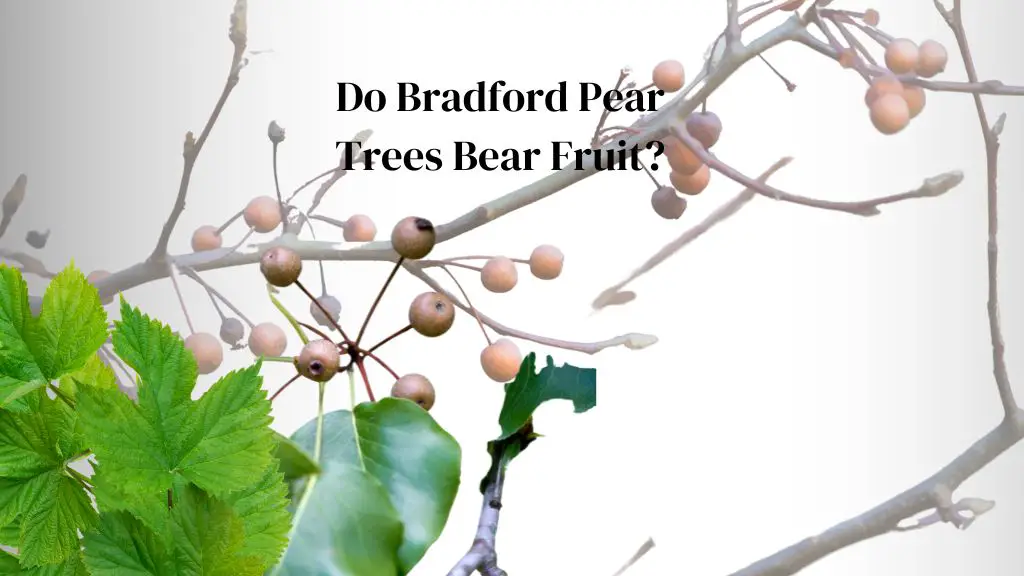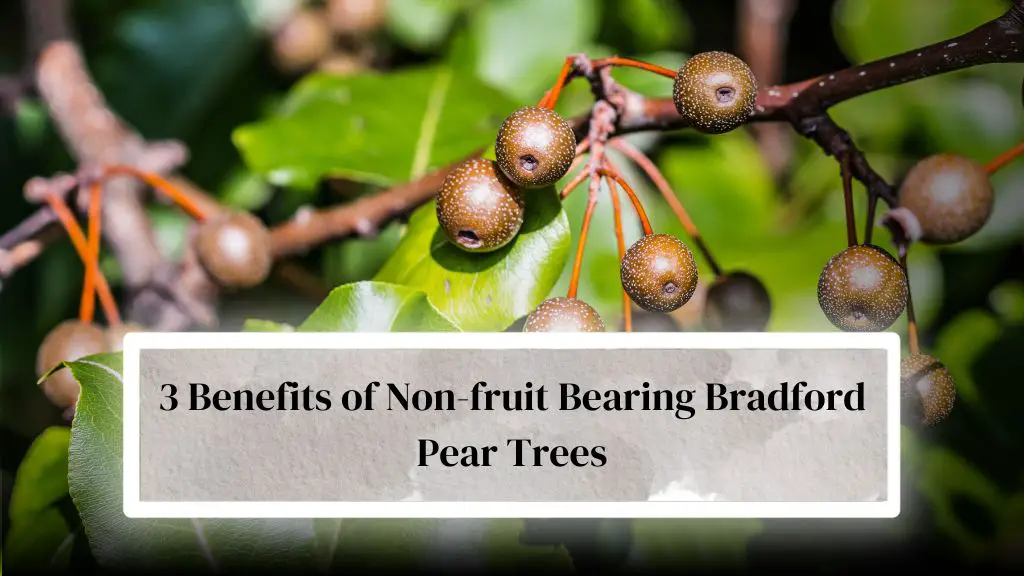
Do Bradford Pear Trees Bear Fruit? Then you’re not alone. Even though Bradford pears are considered sterile, they are known to produce viable fruit if crossed. In this article, I will tell you ‘do Bradford pear trees bear fruit’ or not.
Along with it, we will also take a quick look at the factors that can affect its fruiting and the reason behind it. There are also a few benefits of non-fruit-bearing Bradford pear trees that you should know about.
Later, I will discuss the disadvantages of non-bearing Bradford pear trees, along with alternatives to this specimen. Additionally, if you don’t know how to care for non-bearing trees, don’t worry; I have also covered this topic. But before all these, legs first begin with the basic question: do Bradford pear trees bear fruit?
Do Bradford Pear Trees Bear Fruit?

Despite being originally bred as sterile and thornless, Bradford pear trees can cross-pollinate with other Callery pears cultivars, producing viable fruit. Once ripened, the fruit is consumed and spread by birds, which can lead to the growth of thorny thickets of wild pear trees.
This has also made this species invasive in many areas. This phenomenon has become a concern for some people, as the proliferation of wild pear trees can cause issues in certain areas.
The ability of Bradford pear trees to produce viable fruit through cross-pollination highlights the importance of careful consideration when selecting trees for landscaping & gardening purposes. Let’s take a look at the factors that may affect the fruiting.
Most Read: Is Bradford Pear Tree Fruit Edible?
5 Factors that Affect Fruiting
- Age: You should know that Young trees are less likely to bear fruit than mature trees. According to the University of Georgia Extension, Bradford Pear trees usually start bearing fruit when they are 5-7 years old.
- Pollination: As I told you earlier, Bradford Pear trees are self-sterile, meaning they must be cross-pollinated with another variety to produce fruit. If no compatible pollinators are nearby, your tree will not bear fruit. Some common pollinators for Bradford Pear trees include other cultivars of Pyrus calleryana or other Pyrus species.
- Climate: Unfortunately, The climate can also affect fruiting. Bradford Pear trees require a certain number of chilling hours, which is the number of hours below 45 degrees Fahrenheit, to initiate flowering and fruiting. If you don’t provide them with enough chilling hours, your tree may not produce fruit.
- Pruning: You must avoid Excessive pruning that can reduce fruit production. According to a study published in the Journal of the American Society for Horticultural Science, pruning can decrease fruiting by up to 80%.
- Disease: No doubt, the disease can also affect fruiting. Fire blight, a bacterial disease that causes branches to wilt and turns black, can reduce fruit production.
3 Reasons for Non-fruit Bearing
If your Bradford Pear tree is not bearing fruit, it could be due to one of these reasons:
- Lack of pollination: As mentioned earlier, Bradford Pear trees need to be cross-pollinated to produce fruit. If no compatible pollinators are nearby, your tree will not bear fruit.
- Young age: If your tree is still young, it may need to be mature enough to bear fruit.
- Disease: Disease can also cause a tree not to produce fruit. If your Bradford Pear tree shows signs of disease, such as wilting or blackened branches, it may need to be treated to ensure it can produce fruit in the future.
3 Benefits of Non-fruit Bearing Bradford Pear Trees

While fruiting Bradford Pear trees can add a nice touch of color to a landscape, non-fruit-bearing Bradford Pear trees offer several benefits:
- Low maintenance: Non-fruit-bearing trees don’t require special care to prevent fruit drops or clean up fallen fruit.
- No messy fruits: Bradford Pear fruits are small and hard and can make a mess when they fall. Non-fruit-bearing trees eliminate this issue.
- Aesthetic appeal: Bradford Pear trees are prized for their spring blooms and fall colors. Non-fruit-bearing trees still offer these benefits without the added hassle of fruit.
Alternatives to Bradford Pear Trees
Other Ornamental Pear Tree Varieties
While Bradford Pear trees may not bear fruit, other ornamental pear trees do. For example, the Bartlett Pear is a popular fruit-bearing tree grown for its ornamental value. It produces delicious, juicy pears that can be eaten fresh or used in various recipes.
Other Types of Fruit Trees
If you are looking for fruits, consider planting other trees that produce edible fruit. Not only Bradford pear tree fruit are unsafe for humans but also for pets making them a poor option to have.
However, if you’ve pets, consider reading the article on: Are Bradford Pear Trees Poisonous To Dogs?. There are many fruit trees that you can grow in place of Bradford pear trees, like apple, peach, cherry trees, or plum trees.
Each produces a delicious fruit you can enjoy with your family without worrying about toxins. Plus, these types of trees are also beneficial for the wildlife in your local area.
Caring for Non-fruit Bearing Bradford Pear Trees
Just because Bradford Pears don’t produce fruit doesn’t mean they don’t require care. Here are a few things to keep in mind when caring for your non-fruit-bearing Bradford Pear tree:
Soil and Water Requirements
Bradford Pear trees prefer well-drained, slightly acidic soil. They also require regular watering, especially during periods of drought. Be sure to water your tree deeply so the water reaches the roots.
Pruning and Trimming
Pruning and trimming your non-fruit-bearing Bradford Pear tree can help keep it healthy and looking its best. It’s best to prune your tree in early spring before new growth. Be sure to remove any dead or diseased branches, as well as any that are crossing or rubbing against each other. Here, you can learn how to trim a Bradford Pear tree.
Disease and Pest Management
Since Bradford pear trees tend to have very weak wood, they are susceptible to many types of infestations and diseases if you don’t take proper pest control measures. To know more about this, consider reading “Is Bradford Pear a Hardwood?“. It is important to keep an eye out on your tree for signs of any trouble. Many common issues include fire blight, pear scab, & aphids, which can irritate and infest your tree if you don’t take proper precautions. In any case, if you know these problems with your tree, you must contact a professional arborist to determine the best course of action.
Disadvantages of Non-fruit Bearing Bradford Pear Trees
Bradford pear trees are popular for their beautiful white flowers and fast growth rate. However, they have their drawbacks. This article will discuss the potential risks of Bradford pear trees, their impact on local ecosystems, and their short lifespan.
Potential Risks of Bradford Pear Trees
One of the main concerns with Bradford pear trees is their weak branch structure. As they grow taller, the branches become more prone to breaking, especially during storms or heavy winds.
This can pose a risk to nearby buildings and people. According to a study by the University of Kentucky, Bradford pear trees have a “brittle wood structure” that makes them more susceptible to breakage than other tree species.
Another risk associated with Bradford pear trees is their disease susceptibility. They are prone to fire blight, a bacterial disease that can cause dieback and eventually kill your tree.
In addition, they are also prone to pear scab, a fungal disease that can cause defoliation and reduce your tree’s overall health. These diseases can spread to other trees in the area, making Bradford pear trees a potential source of infection.
Impact on Local Ecosystems
You should know that Bradford pear trees are not native to North America. Since they were introduced, the local ecosystems & community have suffered. You should avoid planting one because they are invasive and can easily outcompete native tree species, harming your area’s biodiversity.
The University of Georgia observed that Bradford pear trees thrive in natural regions and grow in dense, monospecific stands that keep out other plant species. Wildlife that relies on a wide variety of plant species for food and shelter may suffer due to this.
Short Lifespan
Despite their fast growth rate, Bradford pear trees have a relatively short lifespan. According to the Clemson University, the average lifespan of a Bradford pear tree is only 20 to 25 years.
This is significantly shorter than other tree species, such as oak or maple, which can live for several hundred years. As your tree ages, it becomes more prone to disease and branch breakage, making it a potential hazard.
Conclusion
This article has given you complete knowledge of the fruit-bearing capability of trees and what factors can affect their ability. After reading this article, I hope you have no questions regarding the fruit-bearing capacity of this specimen. If you have any other questions regarding ‘Do Bradford pear trees bear fruit,’ let me know in the comment section.
If you find this article helpful, then please share it. Your share will not only help people learn ‘ do Bradford pear trees bear fruit’ or not but also why they should be caring for non-bearing Bradford pear trees. Always check our other articles on Bradford pear trees care & Management posted on this website. See you in the next post. Till then, take care & goodbye.
